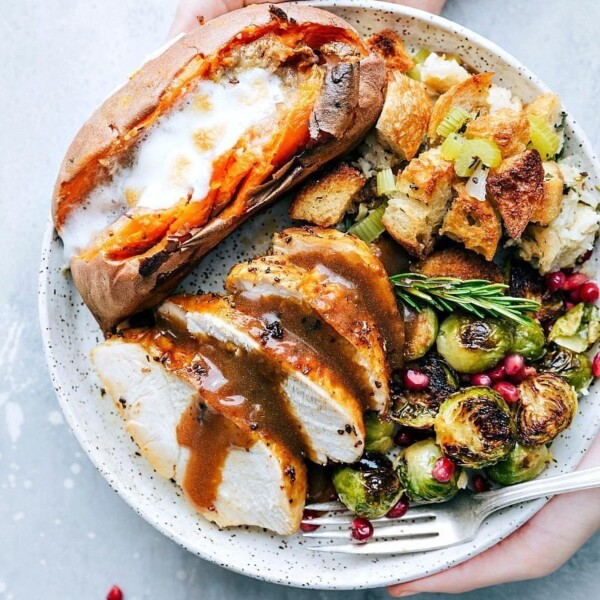Bell peppers are used in so many dishes from salads to pizzas and casseroles to soups. Being such a commonly used vegetable in the kitchen means you’ll want to know the most efficient way to cut a bell pepper. This guide will teach you how to navigate this vegetable to cut it correctly, every time.
Want to practice your new skills? Make sure to check out some of the top recipes from my website that use bell peppers at the end of this post.

Step One: Cut off the Ends
Place a washed and dried bell pepper on a cutting board. Use a sharp knife to cut off about 1/2 inch from both the bottom and the stem end.
These tops and bottoms are edible and can be used as a quick snack or in another recipe where the shape/size of the bell pepper doesn’t matter.
Step Two: Cut off the Sides
Next, cut off the sides (either three or four) as shown in the picture above. I’ve found this technique to be faster and more efficient than cutting the bell pepper in half and removing the ribs/seeds afterward.
In five cuts, you’ll have four sides of the pepper and one large core with seeds attached. Discard the core and seeds.
Quiz Time: Female peppers have only 3 bumps/sides and are better for snacking, whereas male peppers have 4 bumps/sides and are better for cooking. True or False? Answer here
Step Three: Cut into Strips
You now have three or four sections (sides) of the cut bell pepper. Take each section, lay it skin-side down on the cutting board, and use a sharp knife to cut into strips. Depending on the recipe you can cut these strips extremely thin or thick.
For snacking, the thickness of strips is best moderately thin, just over 1/4 inch.
If you are going to be cutting the strips into cubes, be aware of how thick you want the cubes and cut the strip’s thickness accordingly.
Step Four: Cut into Cubes
Thick cubes: Cut thick strips 2-4 times.
Thinner cubes: Cut medium size strips, 4-6 times.
For a DICED pepper: follow steps 1-2 and then for each section of bell pepper make parallel cuts at your desired width but DON’T cut all the way through. Leave 1/4th of one end of the pepper section intact. Rotate the piece 90 degrees and then cut those strips into very small cubes. (leaving the end uncut makes cutting the other direction much easier as the strips stay in place)
Other Cuts:
How to cut bell peppers into a ring:
Complete step one. Run your knife around the inside of the flesh to cut away the core and seeds; discard. Lay the bell pepper on its side and thinly slice it into rings.
How to cut mini peppers:
Cut (washed and dried) mini peppers in half lengthwise and remove the small core. Then prepare as necessary (strips, cubes, dice, etc.).
Step Five: Use your Cut Peppers
Either snack on the peppers with a good veggie dip or use the seasoning mix on this Roasted Vegetable recipe to toss with peppers and roast as a delicious side dish. To incorporate your cut peppers into meals, check out some of the top recipes from my website that use bell peppers:
Here are some of our favorite recipes using bell peppers:
(from top left to bottom right)
Italian Sausage and Veggies (Reader FAVORITE!)
Crockpot Chili (RAVE reviews!)
Couscous Salad (Greek)
Quick Tip
Did you know that green, yellow, orange, and red bell peppers all come from the same plant, just at different stages of ripeness? Green is the pepper at its unripe stage, and it will evolve to yellow and even orange before hitting its peak ripeness (and sweetness) stage at red. Peppers will continue to ripen only when they’re attached to the plant, so putting one on the window sill won’t help it turn red.
How to Cut a Bell Pepper: FAQS
What is the difference between bell peppers?
Green peppers are less sweet and slightly more bitter than yellow or orange peppers. Red bell peppers are the sweetest.
Are bell peppers and capsicum the same?
Scientifically yes, but it depends on which part of the world you are living in and what type of taste you are expecting. More info here.
Which bell peppers are good for cooking?
Bell peppers are amazing raw (especially with a good veggie dip!) and they are great for cooking. As a general rule: the more colorful, sweeter peppers (red/orange) are better for eating raw and the green pepper, with a less sweet taste, is better for cooking.
Is it okay to eat raw bell peppers?
Yes, they’re delicious!
How do you keep peppers fresh after cutting?
Store cut peppers in plastic wrap or in a plastic bag for up to two days in the fridge. Bell peppers do have a tendency to get a little slimy once cut so wrap them in a sheet of paper towel to prevent that.
How do you select the best bell peppers?
At the grocery store, look for a pepper that feels firm and has smooth skin. Look for peppers with vivid color (especially around the stem), minor blemishes, and no soft spots. Choose peppers that feel heavy for their size; peppers that seem light may have been picked too early or lost a lot of their moisture.
Quick Tip
Have you seen the TikTok video that everyone’s talking about? See a fun new hack for cutting a bell pepper! PS: It works!





















Thanks for this easy-to-read and understanding way of doing this. So much additional information that I found interesting and never knew. Thank You, Thank You.
Serve the bell pepper strips as sauteed with eggplant ; added to veggie wraps ; or mixed into ratatouille. Use the diced pepper in salads; stir them into shakshuka ; or sprinkled on top of pasta for a sweet crunch.
MMMM those sound delicious!! Thanks for the great recommendations! 🙂